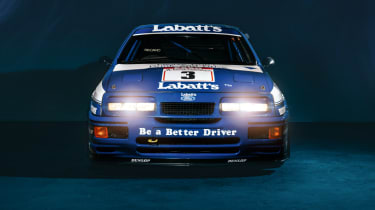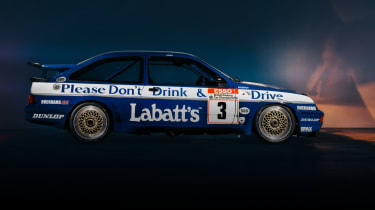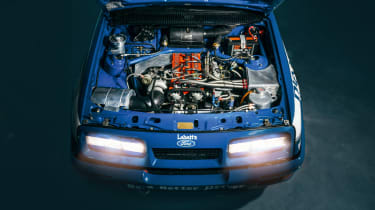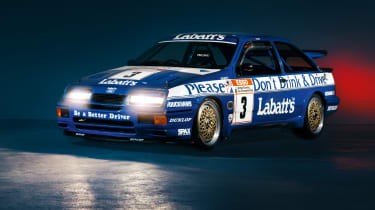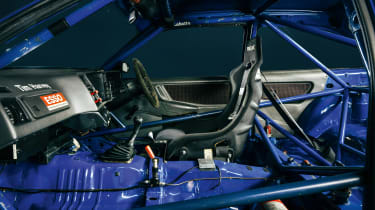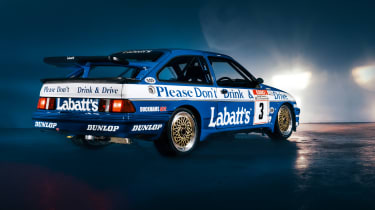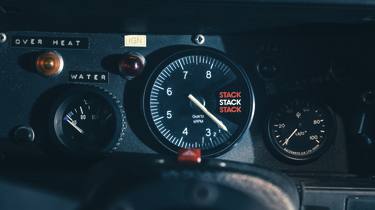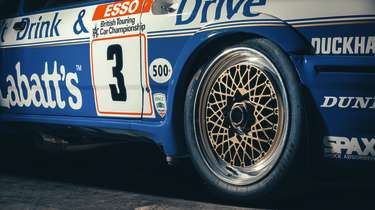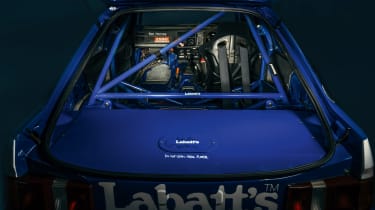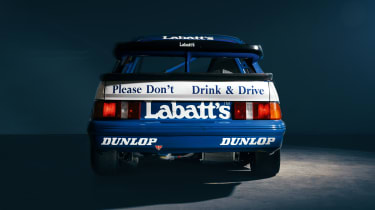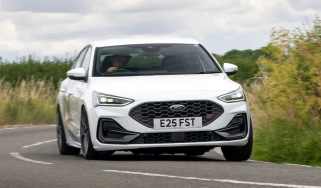Ford Sierra RS500: the anatomy of a BTCC racer
Group A was a golden era in touring car racing, and nothing captured hearts and minds quite like the wild, bewinged Sierra. We look under its skin
You will find no fewer than 813 cars that were homologated for Group A use within the FIA’s Historic Database, and among them some real surprises. The Hyundai Pony is a bit of an eyebrow-raiser, and India’s Hindustan Ambassador even more so. And despite knowing it’s there, you’ll search in vain for an Impreza… until you realise it’s listed under Fuji, Subaru’s parent company.
Then you scroll to Ford, and one car immediately stands out. Whale-tailed, with a ground-scraping splitter, prominent air intakes, a vented bonnet and mesh wheels, the Sierra Cosworth cuts an entirely different form to the prosaic, unadorned shapes used by most manufacturers to ensure their cars were approved for use in sanctioned motorsport. That is, of course, because the Sierra Cosworth was not simply approved for homologation, but a car designed to exploit it: a genuine homologation special.
> Subaru Impreza WRC97: the anatomy of a WRC car
Group A, introduced by the FIA in 1982 primarily to replace Group 2 touring car regulations, has spawned more homologation specials than most. And while the Nissan Skyline GT‑R is revered in Japan and Australia and the BMW M3 and Mercedes 190E Cosworth in Germany, it’s the Ford Sierra RS500 Cosworth that is most fondly remembered across most continents.
The Sierra in racing
Ford’s controversial replacement for the Cortina arrived in 1982, but it wouldn’t be until 1985 that the Sierra made its factory racing debut – and not, as you might expect, with the Cosworth.
Stuart Turner had been a rallying co-driver at BMC in the 1960s before moving to Ford as competition manager at the end of the decade. He would preside over Ford’s motorsport affairs during a rosy period for the Escort (and was the driving force behind the creation of the GT40-powered Supervan), before taking on a new challenge elsewhere in Ford in 1975.
In 1983 he returned to lead the motorsport programme once more and was given the financial resources to put Ford at the top of nearly every major racing discipline, from rallying to Formula 1. Among the more pressing aims was to knock Rover back off its perch in saloon car racing, where the V8-powered SD1 was giving the ageing Capris a drubbing. The new Sierra was chosen for the role.
While Ford Motorsport was working on what would eventually become the Cosworth, a more unusual car was selected in the interim: the Merkur XR4Ti. This US-market variant of the Sierra was powered by a turbocharged, 2.3-litre, single-overhead-cam four-cylinder, which made around 175bhp in road-going form but was coerced to more than 300 horsepower by the time the required 5000 had been built for racing homologation in April 1985.
This was later than intended and meant the Merkurs missed the first race of the 1985 British Saloon Car Championship, but with Andy Rouse at the wheel, Ford owned the rest of the season. Despite this, the car was far from perfect, winning mostly on Rouse’s experience and the car’s power advantage, but the knowledge gained from the project proved invaluable by the time the all-new Cosworth was signed off for racing use in January 1987. The RS500’s homologation would follow in July that year and Rouse’s ICS plc team would swap their regular Cosworths for RS500s in rounds 10 and 11, embarking on a full season in 1988.
The RS500 didn’t need to wait until 1988 to dominate, however, especially in European racing. Like Rouse, Ruedi Eggenberger’s team, with its striking Texaco-liveried cars, had been running the Merkurs almost from day one, and adopted first the Cosworth and then the RS500 as soon as each was ready to race.
The European Touring Car Championship and 1987’s short-lived World Touring Car series used rolling starts, which were easier on the sometimes fragile rear axles that had plagued the XR4Ti and early Cosworths, and the new RS500s simply drove away from their closest competition, the E30 M3 BMWs, every time the flag dropped.
With the ink still drying on the homologation papers, the RS500s finished first and second on their debut outing – at Brno in Czechoslovakia on 16 August – and won several more times before the 1987 season was out. Only a dubious disqualification at Australia’s Bathurst 1000 prevented Ford’s drivers beating BMW’s Roberto Ravaglia to the drivers’ title, but the Eggenberger team still pipped Schnitzer in the entrants’ championship.
From 1988, the Ford’s success was far wider-ranging, with driver titles in DTM (Klaus Ludwig, 1988) and Australian Touring Cars (Dick Johnson in 1988 and 1989), plus wins at Bathurst (1988 and 1989), the Spa 24 Hours (the Eggenberger team again, in 1989) and the Japanese Touring Car Championship in 1987 and 1988. Throughout the era, the only cars that could realistically compete with the Fords were BMW’s ever-evolving M3s, and the growing might of the ‘Godzilla’ Nissan Skylines.
Engine and transmission
The 1993cc turbocharged Cosworth ‘YB’ is probably one of the best-known, most successful and best understood four-cylinder performance engines ever made. It powered not only the Sierra Cosworth road cars but also the RS500 racers, before finding its way into the Escort Cosworth in road and rallying form and the Escort WRC that took over from the Group A cars in Ford’s 1990s rallying campaign.
Admittedly, 201bhp from the original Cosworth road cars seems modest today, as does the 224bhp of the RS500 road cars. But in racing form the YB was making around 340bhp from the off, eclipsing the 330-or-so maximum of the 2.3-litre Lima engine in the earlier racers, and the clue to it delivering its full potential could be found in the RS500 name.
The YB comprised a cast-iron block and a 16-valve aluminium cylinder head designed by Mario Illien at Cosworth. Early versions used a small Garrett T3 turbo but Cosworth kept blowing them up on the test bed, so it was replaced by the larger and more durable T4 – a handy side-effect being an ability to flow enough air for more than 500 horsepower. These RS500 engines are known as the YBD, distinguishing them from the YBB of earlier road-going Cosworths. Among other tweaks, they featured an additional fuel-rail and set of injectors – non-functional on the road car, but a few ECU tweaks and the racers could deliver fuel like a fire tender full of four-star.
Alan Strachan, who worked alongside Rouse on both the Sierras and the later 2-litre touring cars and today runs CNC Motorsport – which among other activities is manufacturing a limited run of full race-spec RS500 continuation cars, built to original specification – says that ECU mapping marked the biggest difference between teams running RS500s. There wasn’t a huge difference in outright power, and all were pushing the limits of what the engine could do – around 550bhp at its peak, though there are rumours some Australian teams made up to 600bhp – but mapping allowed for small differences in power delivery and reliability.
ECUs are also the only real difference in how the cars are run today in demonstrations and historic racing, since the unavailability of original units means modern hardware and software are used instead. ‘You don’t get a huge performance gain though,’ explains Strachan. ‘The main benefits are being able to look after the car better – keeping temperatures down, shutting the thing off if the oil pressure drops – and an improvement in driveability.’
Chassis, bodywork and aerodynamics
The early Merkur racers had used the unusual four-pillar, three-door body of both their road-going counterpart and the XR4i sold in Europe, before moving to the more conventional three-pillar hatchback more familiar from the later Cosworth. Distinctive though the ‘jelly mould’ Sierra body was, it also generated lift at speed and wasn’t great in crosswinds either, as many a 1980s sales rep will confirm. This combination prompted designer Lothar Pinske at Ford’s Special Vehicle Engineering to develop the car’s most distinctive feature: an enormous wing standing proud above the rear hatch, supplemented by an XR4i-style spoiler at the trailing edge of the bootlid.
It generated only a modest 20-or-so kilos of downforce at 70mph, but was much more effective at countering the car’s natural lift, and when the RS500 hit the roads in 1987, the addition of a prominent rubber Gurney flap took that figure to nearer 100kg at 100mph. Together with a deep front air dam – with cut-outs and the ditching of a pair of running lights in the front bumper to feed air to the intercooler and radiator, engine air intake, and brakes – the Sierra now had a body to match its performance. And, with Group A being a production-based formula, one that was conveniently homologated to work well on track, too.
In many respects there was nothing special about the RS500’s running gear. Front suspension was Ford’s favoured MacPherson strut arrangement and there were trailing arms at the rear, hanging from a subframe that also housed the rear differential. Where the RS500 differed from the conventional Sierra, and indeed the regular Cosworth, was an additional set of mounting points to give racing outfits the option to relocate the trailing arms, and therefore make larger geometry changes.
Production of the road-going RS500s was handed to Aston Martin Tickford, who received complete Sierra Cosworths before removing and modifying their aerodynamic parts and doing the same with the Cosworth-built YBs, swapping them for the more potent YBDs and their large front-mounted intercoolers, plus extra heat shielding.
The RS500s then went just about everywhere to be turned into full racing machines with cages and seam-welded shells. The best-known in the UK was Andy Rouse Engineering (ARE), but when Robb Gravett took his BTCC title in 1990 it was with cars built by Australia’s Dick Johnson Racing and engines developed by Mountune, while Eggenberger was the big player in the European scene. Tyre choice too was wide-ranging: in the BTCC, cars ran everything from Yokohama (Gravett) to Pirelli (Rouse) to Dunlop (the ARE car in our photos).
Driving the RS500
The whale tail is only part of the Group A RS500’s visual appeal; for those who grew up watching 1980s touring car racing, the liveries are just as iconic. Black and red Texaco cars, Bastos red and white, the white and blue of Kaliber, and the Labatt’s ‘Don’t Drink and Drive’ blue and white of Tim Harvey’s 1989 and 1990 ARE-prepared cars.
Harvey, who would win the 1992 BTCC title for BMW in that dramatic Silverstone finale involving a clash between Steve Soper and John Cleland, took a pair of race wins in the Labatt’s car in 1989, and secured a pair of Class A third-place season finishes in ’89 and ’90 in an era when the fastest car outright – typically a Sierra – wasn’t necessarily guaranteed an overall title.
As Rouse himself noted when we covered Group A’s successor, the 2-Litre Formula, back in evo 246, that sometimes made for a confusing spectacle, and Harvey admits that the Sierra’s near-singlehanded command of the races, if not the championship points, probably helped hasten its demise. ‘For those of us that drove them, though, we absolutely loved them,’ he says.
Harvey first stepped into the car in 1988, having come from a season in the Rover Vitesse in 1987. ‘It was a bit like getting a computer with a faster processor,’ he says. ‘We’d been racing against Andy [Rouse] in the Merkur, so we had an idea of what the car was going to be like, but it was still a different beast. The Vitesse was a lovely, cuddly bear of a car, more of an endurance car than a sprint car – it was quite heavy, and had that V8 engine making around 350 horsepower. Then bosh, straight out of nowhere comes the Cosworth. It was lighter, more agile, and was making well over 500 horsepower even to start with.’
The RS500 has developed a reputation for being a bit of a monster, something Harvey does little to dispel: ‘It was certainly an upgrade – as a driver you always want more power and more grip. The car had developed fairly quickly into the beast it was, and at the time they just couldn’t make the tyres last, so you always had more power than grip and were then trying to control it on rapidly degrading tyres. It took a lot of manhandling, a lot of controlling as the tyres went off.’
The tyres improved over time, but only as the power itself grew, so this balancing act was something RS500 drivers always had to contend with. The benefit was that little could touch the Sierra on the faster circuits, though despite its traction limitations out of slower corners it was hardly a one-trick pony, and in the hands of Harvey, Rouse, Gravett and others, took wins almost everywhere, including endurance races that prioritised durability as well as speed.
‘It was a pretty good handling car. There was always fine-tuning to do, geometry, dampers, roll bars, the usual things, but the experience was really dominated by the engine performance. It was always about exit speed – you’re vee-ing the corner, in terms of stopping the car, turning, and powering out again, compared to the E30 M3 which was all about maximising your minimum corner speed.’
Harvey moved to the E30 in 1990 in the first year that 2-litre cars ran alongside Group A, something that, to begin with at least, felt like a bit of a comedown. ‘In the DTM they’d been running 2.5-litre screamers, but the British regs limited the cars to 2 litres. After 560 horsepower, they felt pretty underpowered…’
Getting back behind the wheel at the Super Touring Power event at Brands Hatch in 2023, familiar sensations came flooding back: ‘It’s funny when you get back into a car you’ve not sat in for years – you were so familiar with it back in the day, the sound of the starter motor, the smell, the mechanical engagement and the sounds, that driving it again is completely instinctive, like you’ve never been away. It’s so emotive and evocative – and it’s still an absolute beast.’
The demise of Group A touring cars
The Sierra’s success, and that of the Skyline GT-R in Australia, ultimately spelled the end of Group A touring car racing. The likes of Rouse and Prodrive’s David Richards drafted the 2-Litre Touring Car Formula with the idea of making it accessible to as many manufacturers as possible, and after a year alongside Group A in 1990 – the year an RS500 finally won the series outright, with Robb Gravett at the wheel – the BTCC switched exclusively to 2-litre cars from 1991.
The rest is history, and as even Harvey says: ‘2 litres was probably the way to go – it proved to be absolutely the correct decision.’ The 2-litre touring cars, which evolved into the formula we know today as Super Touring, created some of the most action-packed racing the sport has ever seen and has gone down in history as one of the golden eras of the BTCC, maybe even eclipsing Group A as a fan favourite.
But while British racing turned its back on Group A, there was still life left in the category elsewhere. DTM carried on with the regulations until the end of 1992, and its final years witnessed some incredible machines, such as the Audi V8 Quattro and the bewinged Mercedes-Benz 190E Evolution II. The Japanese Touring Car Championship, one of the precursors to today’s Super GT series, and Australian Touring Cars, which predated V8 Supercars, also hung on until 1992.
Group A is undoubtedly one of the greatest racing classes in history, and, valiant efforts from the Hyundai Pony and Hindustan Ambassador aside, the Sierra RS500 remains one of its biggest stars.
Thanks to Alan Strachan at CNC Motorsport, Tim Harvey, and First Choice Bodyshop for providing the photography location. This story was first featured in evo issue 325.

